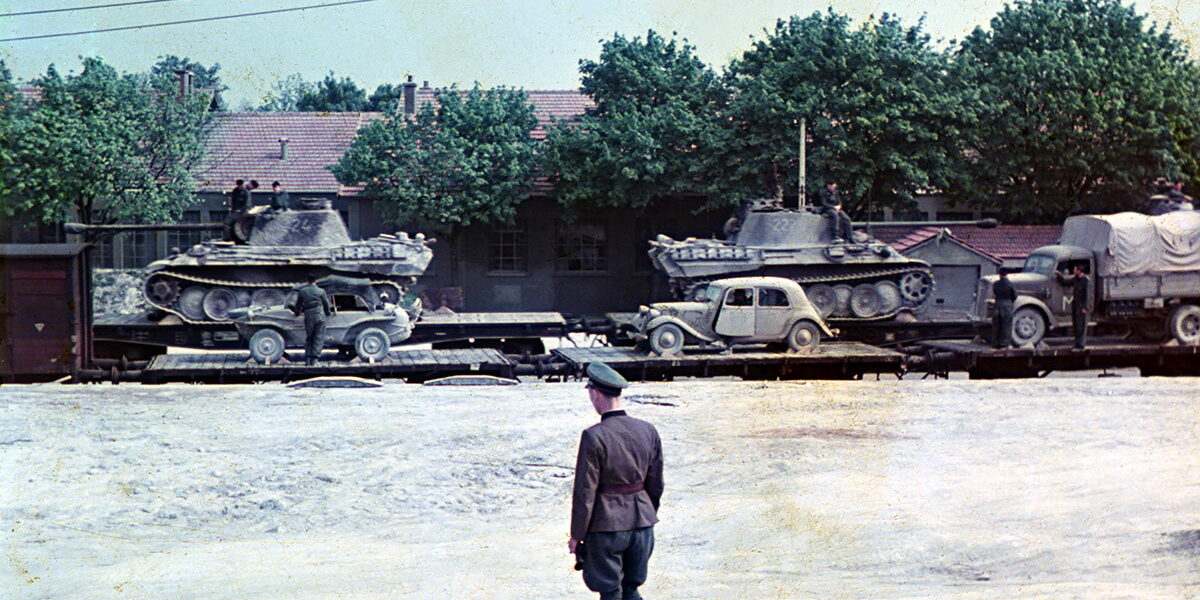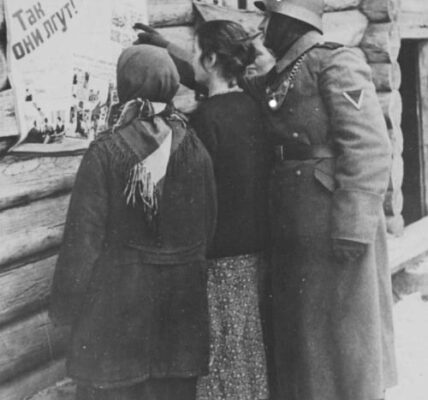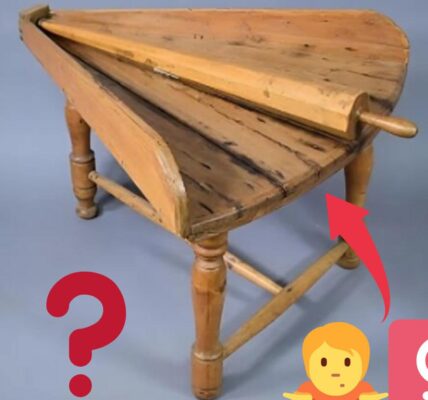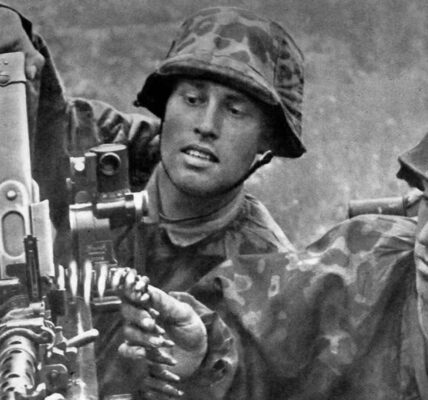
Two Panzerkampfwagen V Panther tanks are transported by rail. This photo was taken around 1944 at the Mailly-le-la-Département depot in Aube, France. Departure to Normandy?
Armored vehicles, also known as tanks, played a crucial role in the First World War in the struggle of France, Russia, and Great Britain against the Triple Alliance of Germany, Austria-Hungary, and Italy. Tanks made it possible to shift the advantage from defensive to offensive maneuvers, and their use took the alliance completely by surprise. Germany eventually developed its own tank, the A7V. However, after the armistice, all German-owned tanks were confiscated and scrapped. Various treaties prohibited Germany from owning and building armored vehicles.
All this changed with Adolf Hitler’s rise to power and the beginning of the Second World War.
Design & Development
Development of the Panther began in 1941, after Germany encountered Soviet T-34 tanks in the early days of Operation Barbarossa. The T-34 proved superior to the existing tanks, the Panzer IV and Panzer III, and inflicted heavy losses on German tank units. In the autumn of that year, after the capture of a T-34, a team was dispatched to the East to study the Soviet tank and develop a superior tank. Upon returning with the results, Daimler-Benz (DB) and Maschinenfabrik Augsburg-Nürnberg AG (MAN) were commissioned to design new tanks based on the study.
When evaluating the T-34, the German team determined that the key to its effectiveness was its 76.2 mm cannon, wide road wheels, and sloped armor. Based on this data, DB and MAN submitted proposals to the Wehrmacht in April 1942. While the DB design was largely an improved copy of the T-34, MAN incorporated the T-34’s strengths into a more traditional German design. The MAN design had a three-man turret (the T-34 had room for two), was taller and wider than the T-34, and was powered by a 690 hp gasoline engine. Although Hitler initially favored the DB design, the MAN design was chosen because it used an existing turret design and was faster to produce.
Upon completion, the Panther was 6.8 meters long, 3.4 meters wide, and 2.8 meters high. It weighed around 50 tons and was powered by a V12 Maybach gasoline engine with approximately 690 hp. It reached a top speed of 55 km/h and a range of 250 km. The crew consisted of five men: driver, radio operator, commander, gunner, and loader. Its primary armament was a Rheinmetall-Borsig 1 x 7.5 cm KwK 42 L/70 cannon, and its secondary armament consisted of two 7.92 mm 34 machine guns.
It was built as a “medium” tank, a classification that lay somewhere between light, mobility-oriented tanks and heavily armored body armor.
Production
After prototype trials at Kummersdorf in the autumn of 1942, the new tank, designated the Panzerkampfwagen V Panther, entered production. Because the new tank was needed on the Eastern Front, production was accelerated; the first examples were completed as early as December of that year. As a result of this rush, the early Panthers suffered from mechanical and reliability problems. In the Battle of Kursk in July 1943, more Panthers were lost due to engine problems than due to enemy action. The most common problems included overheated engines, connecting rod and bearing damage, and fuel leaks. In addition, this type suffered from frequent transmission and axle drive failures, which proved difficult to repair. Therefore, all Panthers were overhauled at Falkensee in April and May 1943. Subsequent design improvements helped to reduce or eliminate many of these problems.
While initial production of the Panther was contracted to MAN, demand for the type soon exceeded the company’s resources. As a result, the DB, Maschinenfabrik Niedersachsen-Hannover, and Henschel & Sohn received contracts to build the Panther. Around 6,000 Panthers were built over the course of the war, making the tank the Wehrmacht’s third most produced vehicle after the Sturmgeschütz III and the Panzer IV. At its peak in September 1944, 2,304 Panthers were operational on all fronts. Although the German government set ambitious production targets for Panther construction, these were rarely met, as Allied bombing raids repeatedly targeted vital aspects of the supply chain, such as the Maybach engine plant and several Panther factories themselves.
introduction
The Panther entered service in January 1943 with the formation of Panzerabteilung (Bataillon) 51. After Panzerabteilung 52 was equipped with it the following month, larger quantities of this type were sent to front-line units in the spring of that year. Because the Panther was considered a key component of Operation Citadel on the Eastern Front, the Germans delayed the start of the Battle of Kursk until sufficient numbers of this tank were available. In its first major use during combat, the Panther initially proved ineffective due to numerous mechanical problems. After the production-related mechanical problems were resolved, the Panther enjoyed great popularity among German tankers and became a fearsome weapon on the battlefield. While originally intended to equip only one tank battalion per Panzer division, by June 1944 it accounted for almost half of the German tank strength on the Eastern and Western Fronts.
The Panther was first used against US and British forces at Anzio in early 1944. Because it was deployed in limited numbers, US and British commanders considered it a heavy tank that would not be built in large numbers. When Allied troops landed in Normandy in June of that year, they were shocked to discover that half of all German tanks in the area were Panthers. Far superior to the M4 Sherman, the Panther inflicted heavy losses on Allied tank units with its high-velocity 75mm cannon and could fight at longer ranges than its opponents. Allied tankers soon discovered that their 75mm cannons could not penetrate the Panther’s frontal armor, requiring flank attacks.





